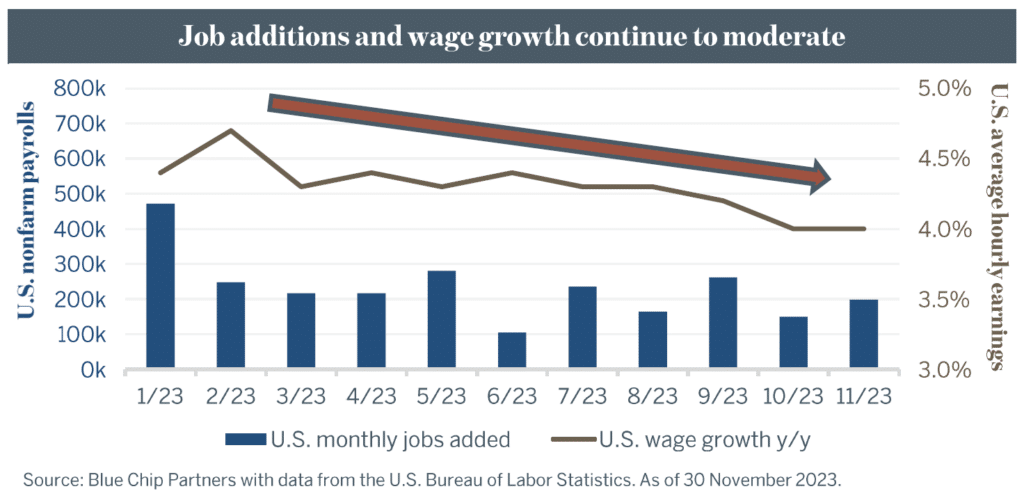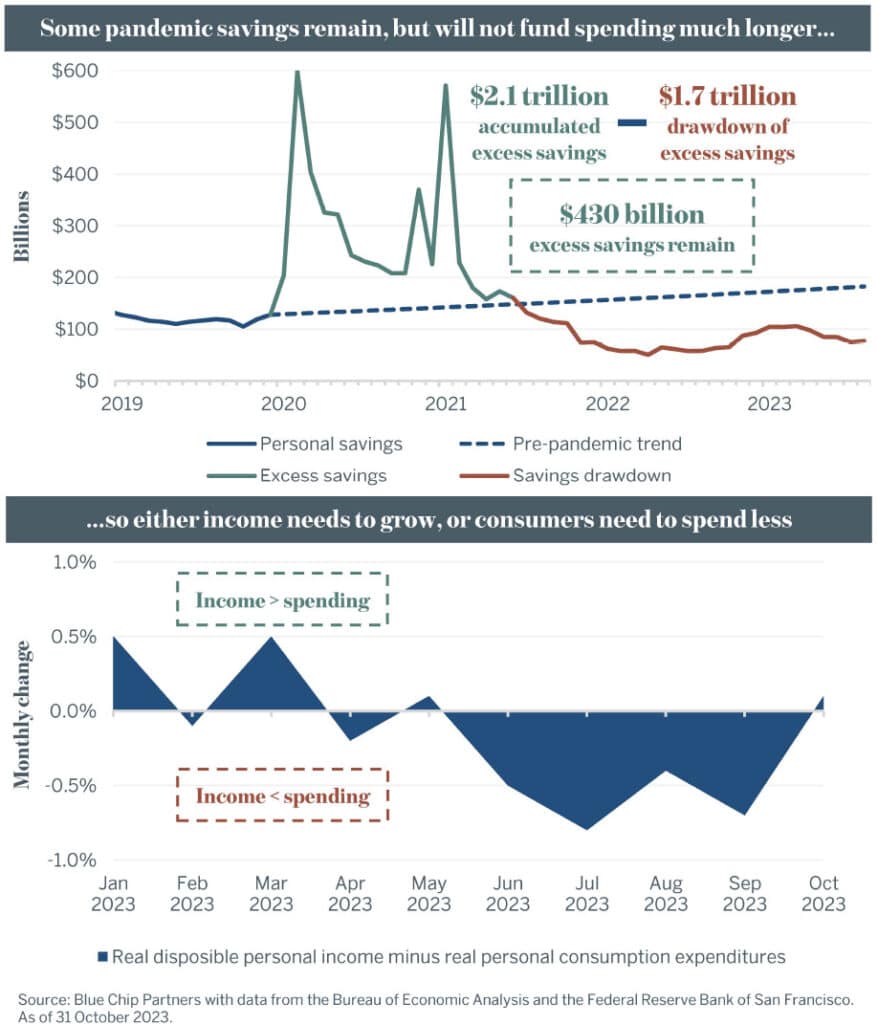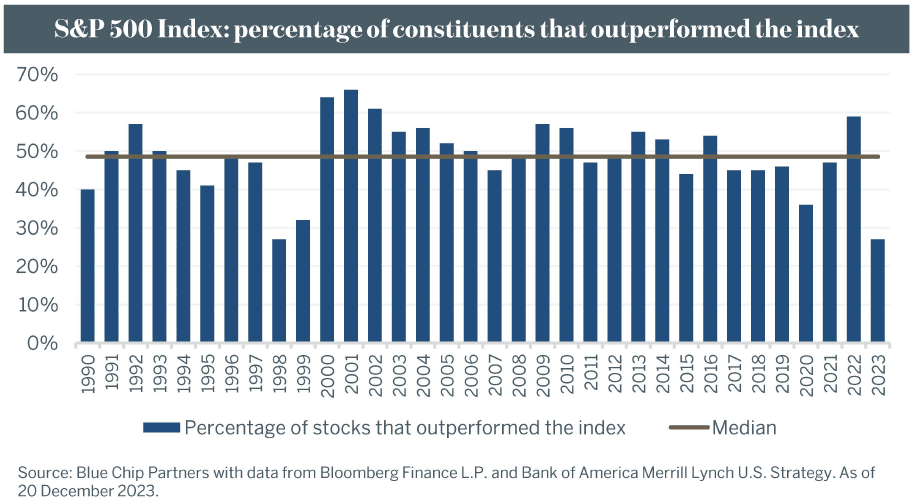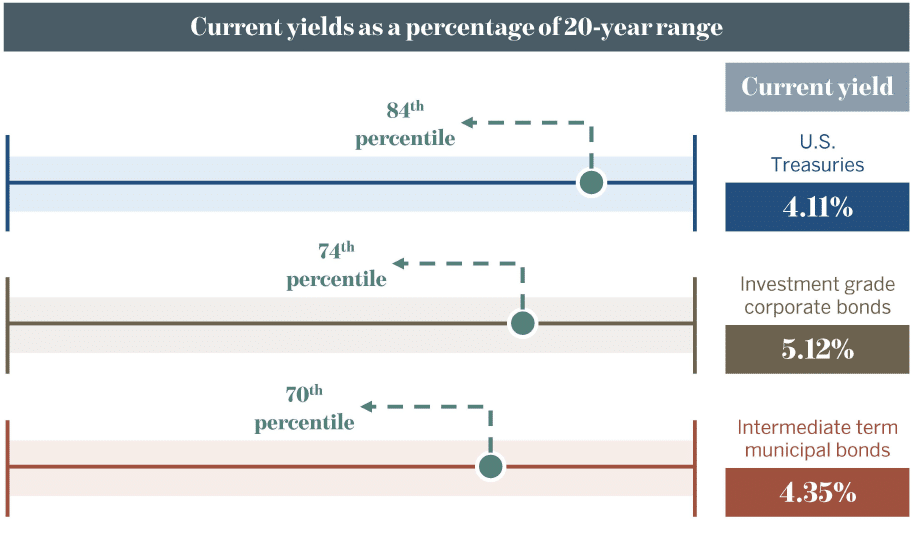Click here to download our full Quarterly Edge Report for Q1 2024:
Q1 2024 Market Outlook
After a tumultuous experience in calendar year 2022, market returns in 2023 served as a welcome relief for investors that stayed the course. The domestic economy avoided recession amid declining inflation and resilient consumer spending, an improved corporate earnings backdrop fueled stocks, and a lower degree of upward interest rate pressure from the Federal Reserve benefitted bond prices. Dramatic differences in underlying dynamics between 2022 and 2023 yielded dramatically different results, which is a trend we see continuing as the cycle matures. In 2024, public market investors will have plenty to wrestle with, but we remain optimistic on the potential outcome for those that are looking to put capital to work.
In the U.S. economy, we see 2024 as a year that displays slower growth, but growth still the same.
Within the domestic equity market, we maintain our stance that selectivity is warranted, but do anticipate a broadening of returns across the subset.
In fixed income, yields remain attractive, and we view the coming environment as one that is friendly for bond investors.
Your Bottom Line
We expect slower growth, which is already reflected in the Fed’s projections:
In 2023, the U.S. economy showed remarkable resilience. As we turn the calendar to 2024, we expect the path forward to be one of more moderate growth for the largest economy in the world. A slowing labor market and signs of consumer exhaustion both support this expectation.
Ensure balanced equity exposure with a preference for high quality companies:
The domestic equity market was incredibly top heavy over the past year. We anticipate greater market breadth in 2024, and see the risk / reward construct as skewed in favor of the companies that were left behind by last year’s narrow market rally.
Reduce money market exposure (not stocks) to reach target fixed income allocation:
We continue to believe that the higher quality subset of the bond market poses an attractive value proposition. Fixed income yields remain near 20-year highs, and with an extended interest rate pause by the Federal Reserve likely turning to stimulative measures in 2024, bonds are poised to benefit.
Slower, but not stagnant
It is fair to say that the economic trajectory seen in 2023 was dramatically different than what was put forth by market pundits at the onset. In the face of greater than 5% in rate hikes and a banking crisis, the U.S. economy showed remarkable resilience. This included a durable downtrend in inflation, supportive consumer spending, and a robust labor market. As we turn the calendar to 2024, we expect the path forward to be one of more moderate growth for the largest economy in the world. A slowing labor market and signs of consumer exhaustion both support this expectation.
Labor market
Economically, we remain of the belief that focus from an economic perspective should be turned to the labor market. With inflation in more sustainable positioning, the Fed will be doing the same – any stimulative measures enacted by the central bank will likely be in attempt to counteract a softening employment picture. Hearkening back to our Q4 2023 Quarterly Edge, we are encouraged that the supply / demand construct in the labor market (the jobs-workers gap) continues to display greater balance. That said, the medium-term trends of lower monthly job additions and a decreased level of job openings are elements that we see continuing in 2024. This would lead the labor market to shift from undersupplied to oversupplied, which is consistent with previous economic slowdowns.
Consumer exhaustion
Given consumer spending accounts for ~70% of U.S. GDP, the measure will always hold high influence over economic cycles. The post-pandemic experience has been unique as strength in spending was fueled by significant monetary and fiscal stimulus, which allowed consumers to bulk up savings well in excess of the prior trend. More recently, the resilience of consumer spending has been driven by drawing on said savings. Amid a more challenging macro backdrop, consumers remained comfortable dipping into savings given confidence in what has been a very tight labor market. The drawdown of elevated savings has been in play for over two years, so why are we calling this out now? Dynamics are different now, as wage growth has slowed and will likely moderate further. With a lower savings buffer and individuals spending above their income capability, softer consumer spending (and thus, economic growth) is likely in 2024.


2024: a “breadth” of fresh air
The return in the U.S. equity market, as measured by the S&P 500 Index, was incredibly top heavy in 2023. As a capitalization-weighted index, when the largest companies display strong performance, index results will be pulled upwards, potentially masking the performance of companies with less emphasis within the index. Enter the so called “Magnificent 7”, who represent 7 of the largest domestic corporations that accounted for nearly 65% of the S&P 500’s return in 2023.
To say this phenomenon was abnormal would be a gross understatement. Years in which the largest companies outperform is not uncommon, but it was the magnitude experienced in 2023 serves as an outlier. Since 1990, on average, roughly half of the S&P 500 constituents outperform the index during a calendar year. Last year, only -30% of companies bested the index – the lowest reading since 1998. Further, the return spread between the traditional S&P 500 and its equal weighted counterpart (S&P 500 Equal Weighted Index) was nearly 13% – once again, the most significant reading since 1998. Given the calendar year performance leadership between the two indices is dead even since 1990 (the traditional S&P 500 has outperformed the S&P 500 Equal Weighted in 17 calendar years, and vice versa), the massive outlier result has the potential to reverse next year.
In 2024, we anticipate a broadening of performance in the equity market. Increased market “breadth” feels natural, as many of the companies that were left behind during 2023’s narrow market rally align with historically strong performers in an economic scenario we outlined in the previous section (recall our coverage of companies that generally outperform in the slowdown phase of the economic cycle from the (Q4 2023 Quarterly Edge). Selectivity will be required, and while we remain optimistic regarding a subset of the companies that drove performance in 2023, the current risk / reward proposition skews in favor of companies that were relatively out of favor over the last year.


Flight to fixed income
We continue to believe that the higher quality subset of the fixed income market poses an attractive value proposition. With economic data set to moderate and the Fed slated to take a more balanced policy stance in 2024, bonds are in position to deliver an attractive level of income and should benefit from a confluence of supportive factors. Even after a stark rally across the fixed income market to close the year, current yields available across the bond market remain near 20-year highs. Given that starting yields display a high degree of correlation with future returns in high quality fixed income securities (see the Q3 2023 Quarterly Edge), the entry point remains enticing.

With an extended interest rate pause by the Federal Reserve that will likely turn to rate cutting in 2024, bonds are poised to benefit. Investment grade corporate bonds boast strong balance sheets without broad need for refinancing, and thus in a slower growth environment, investors can collect coupons without substantial downside risk. If the economy slows more than expected, treasuries would likely benefit, which could offset any widening in spreads. Finally, as households in the U.S. have leaned into money market funds in the last year, we maintain the belief that individuals may move more capital into bonds to lock in these attractive yields, supporting prices.
Source: Blue Chip Partners with data from Bloomberg Finance LP. As of 20 December 2023. U.S. Treasuries are represented by the Bloomberg US Treasury Index. Investment grade corporate bonds are represented by the Bloomberg US Corporate Bond Index. Intermediate term municipal bonds are represented by the Bloomberg Municipal Bond 5 Year (4-6) Index. Yield shown for intermediate term municipal bonds is reflective of the tax-equivalent yield for an individual in the 37% federal income tax bracket.
Looking for more market insight?
Join us live on January 17th and listen to our Director of Investments, Daniel Dusina, dive deeper into the latest Quarterly Edge report, where he will discuss three key things we are watching this quarter. This is your opportunity to ask Daniel your questions. Register for the webinar at the link below!
Wednesday, January 17th, 2024
4 P.M. ET – 4:30 P.M. ET
Click below to save your spot!
Disclaimer:
Expressions of opinion are as of this date and are subject to change without notice. Any information provided is not a complete summary or statement of all available data necessary for making an investment decision and does not constitute a recommendation to buy, hold, or sell any security. There are limitations associated with the use of any method of securities analysis. The information has been obtained from sources considered to be reliable, but we do not guarantee that the foregoing material is accurate or complete. Every investor’s situation is unique, and you should consider your investment goals, risk tolerance, and time horizon before making any investment. Prior to making an investment decision, please consult with your financial advisor about your individual situation. Past performance does not guarantee future results. Investing involves risk, and you may incur a profit or loss regardless of strategy selected. There is no guarantee that any statements, opinions, or forecasts provided herein will prove to be correct. Dividends are not guaranteed and must be approved by the company Board of Directors. Indices are included for informational purposes only; investors cannot invest directly in any index.